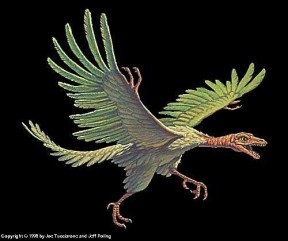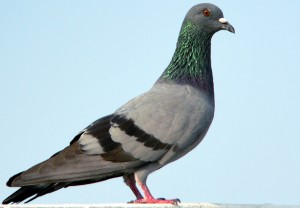
 The many species of birds that we have come to know today all have a common ancestor, which interestingly enough is the velociraptor. During the Jurassic period of the Mesozoic era, between 200 and 145 mya, theropods, a species of dinosaur including the velociraptor and tyrannosaurus and noted for having hollow bones, three principal toes, and even feathers in some cases, began to evolve into birds. Archaeopteryx, a descendant of the theropods, is the earliest member of the class Aves, and over tens of millions of years, it slowly began to give rise to many new species. (1) Around 50 mya there was a major increase in diversification that spurred the evolution of the 9,993 species of birds we know today, one of which is the rock pigeon or rock dove. (2) The rock pigeon’s exact place of origin is uncertain to say the least; however, the range has been narrowed to somewhere around the convergence of Europe, Asia, and North Africa. It was here that the many uses of pigeons appear to have become evident early on leading to the domestication of the rock pigeon by humans between 5000 and 10,000 years ago. (3) Upon their domestication, rock pigeons appear to have followed closely with humans in their expansion to nearly everywhere on the planet, with pigeons only finding the Sahara desert and Antarctica uninhabitable. Rock pigeons and some of the early pigeon subspecies were interbred by the earliest fanciers, which combined with their tendency to return to the wild and become feral, has led to the hundreds of species of pigeons and doves alive today. (3) Interestingly enough, the terms pigeon and dove actually refer to the same species and are not actually two different animals. Dove is often used to describe smaller species of pigeons; however, they are not genetically different from pigeons and belong to the same sub family, Columbinae. The phenomenal species diversity of the pigeon family is depicted below as well as in the background of the blog.
The many species of birds that we have come to know today all have a common ancestor, which interestingly enough is the velociraptor. During the Jurassic period of the Mesozoic era, between 200 and 145 mya, theropods, a species of dinosaur including the velociraptor and tyrannosaurus and noted for having hollow bones, three principal toes, and even feathers in some cases, began to evolve into birds. Archaeopteryx, a descendant of the theropods, is the earliest member of the class Aves, and over tens of millions of years, it slowly began to give rise to many new species. (1) Around 50 mya there was a major increase in diversification that spurred the evolution of the 9,993 species of birds we know today, one of which is the rock pigeon or rock dove. (2) The rock pigeon’s exact place of origin is uncertain to say the least; however, the range has been narrowed to somewhere around the convergence of Europe, Asia, and North Africa. It was here that the many uses of pigeons appear to have become evident early on leading to the domestication of the rock pigeon by humans between 5000 and 10,000 years ago. (3) Upon their domestication, rock pigeons appear to have followed closely with humans in their expansion to nearly everywhere on the planet, with pigeons only finding the Sahara desert and Antarctica uninhabitable. Rock pigeons and some of the early pigeon subspecies were interbred by the earliest fanciers, which combined with their tendency to return to the wild and become feral, has led to the hundreds of species of pigeons and doves alive today. (3) Interestingly enough, the terms pigeon and dove actually refer to the same species and are not actually two different animals. Dove is often used to describe smaller species of pigeons; however, they are not genetically different from pigeons and belong to the same sub family, Columbinae. The phenomenal species diversity of the pigeon family is depicted below as well as in the background of the blog.
3 Comments
Leave a Reply
You must be logged in to post a comment.

21 Jan ’14 @ 12:34 pm
A student (13yrs) is making a study of pigeons in WW1. He is currently looking into the evolution of pigeons. This article is very interesting. Thank you
17 Oct ’21 @ 3:56 pm
I used to be a Creationist, until I learned from evolutionary theory that has been confirmed as true.
25 Dec ’21 @ 7:16 pm
Pigeon eggs contain a materials that bind bacterial surface glyco-proteins and immobilize them like a pathogen mop. An interesting evolutionary advantage that may explain why pigeons can live, eat and procreate in squalor.